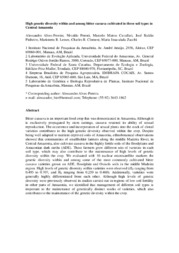High genetic diversity within and among bitter cassava cultivated in three soil types in Central Amazonia.
High genetic diversity within and among bitter cassava cultivated in three soil types in Central Amazonia.
Autoria: ALVES-PEREIRA, A.; PERONI, N.; CAVALLARI, M. M.; PINHEIRO, J. B.; LEMES, M. R.; CLEMENT, C. R.; ZUCCHI, M. I.
Resumo: Bitter cassava is an important food crop that was domesticated in Amazonia. Although it is exclusively propagated by stem cuttings, cassava retained its ability of sexual reproduction. The occurrence and incorporation of sexual plants into the stock of clonal varieties contributes to the high genetic diversity observed within the crop. Despite being well adapted to nutrient deprived soils of Amazonia, ethnobotanical observations showed that communities of smallholder farmers along the middle Madeira River, in Central Amazonia, also cultivate cassava in the highly fertile soils of the floodplains and Amazonian dark earths (ADE). These farmers grow different sets of varieties in each soil type, which may also contribute to the maintenance of high levels of genetic diversity within the crop. We evaluated with 10 nuclear microsatellite markers the genetic diversity within and among some of the most commonly cultivated bitter cassava varieties grown on ADE, floodplain and Oxisols soils in the middle Madeira region. High levels of genetic diversity within varieties were observed (HO ranging from 0.495 to 0.707, and HE ranging from 0.250 to 0.460). Additionally, varieties were generally highly differentiated from each other. Although high levels of genetic diversity were previously observed in studies carried out in regions of low soil fertility in other parts of Amazonia, we identified that management of different soil types is important to the maintenance of genetically distinct stocks of varieties, which also contributes to the maintenance of the genetic diversity within the crop.
Ano de publicação: 2014
Tipo de publicação: Resumo em anais e proceedings
Unidade: Embrapa Cocais
Palavras-chave: Amazonia, Bitter cassava, Cassava, Diversidade genética, Mandioca, Reprodução
Observações
1 - Por padrão são exibidas publicações dos últimos 20 anos. Para encontrar publicações mais antigas, configure o filtro ano de publicação, colocando o ano a partir do qual você deseja encontrar publicações. O filtro está na coluna da esquerda na busca acima.
2 - Para ler algumas publicações da Embrapa (apenas as que estão em formato ePub), é necessário ter, no celular ou computador, um desses softwares gratuitos. Sistemas Android: Google Play Livros; IOS: iBooks; Windows e Linux: software Calibre.
Acesse outras publicações
Acesse a Base de Dados da Pesquisa Agropecuária (BDPA) para consultar o acervo completo das bibliotecas da Embrapa.

